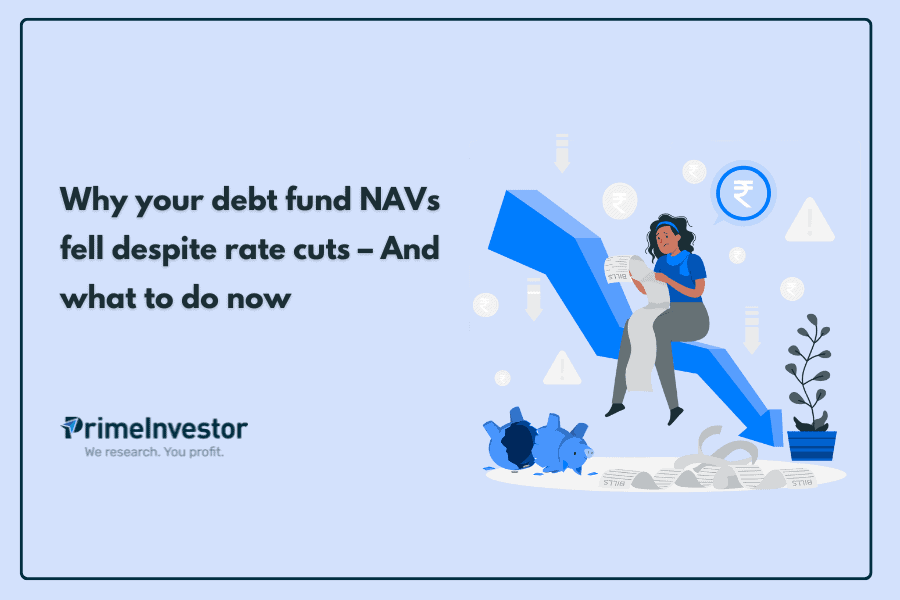Why are duration fund NAVs falling after June 6? Aren’t rate cuts expected to boost bond prices? This puzzling question tops the list of your inquiries to us, following the MPC’s 50-basis point repo rate cut to 5.5% and 100-basis point CRR reduction on June 6. Many are also wondering whether to pivot their debt strategy toward long-duration funds or stick with accrual plays like corporate bond and credit risk funds

The answer to these questions is that bond markets have already factored in rate reductions before the June 6 meeting. Therefore, this is not the time to bet on gains from owning long-duration bonds. Accrual strategies too may not deliver the high yields investors have come to expect.
In recent years, India’s bond market, like the stock market, has been running well ahead of events. Therefore, investors need to anticipate MPC actions and not follow them, to earn higher returns. Nothing demonstrates this better than what happened to bond yields right after the MPC meeting.
After the MPC announced its repo rate and CRR cut on June 6, this is how bond yields moved.
- The yield on the 5-year g-sec (government securities) increased from 5.75% before the MPC meeting, to 6% on June 16.
- The yield on the benchmark 10-year g-sec increased from about 6.13% before the MPC meeting, to 6.38% on June 16.
- The yields on 91-day, 182-day and 364-day treasury bills at 5.4-5.5%, were almost unchanged from their pre-meeting levels.
- The yields on 1 year AAA rated corporate bonds fell 15 basis points but those on 3 year and 5-year bonds stayed put.
This goes to show that though the MPC announced material rate cuts in both the repo and CRR, bond yields across tenors and instruments did not fall after the event. In some cases, they actually increased. This is why funds holding long duration bonds saw a fall in their NAVs after the meeting.
Why yields rose
There are four reasons why the bond markets had this peculiar reaction to the June 6 meeting.
- Factored in: Soon after the MPC ended its last rate hiking cycle in February 2023, markets began to speculate about when the cycle would reverse and the MPC would begin to cut rates. The 10-year g-sec yield therefore peaked out sometime in October 2023 at 7.3%. The US Fed began to trim rates in September 2024. This accelerated rate cut hopes, moderating Indian g-sec yields to 6.8% levels by October 2024. By the time the MPC actually began to cut rates in February 2025 and said that it would prioritize growth over inflation, the 10 year g-sec was already down to 6.5% levels, 90 basis points below its 2023 high.
This goes to show that markets have been factoring in rate cuts for a long time now.
The table below, which captures yield movements since October 2023, shows that market yields fell by between 80 and 146 basis points between October 2023 and June 5, 2025, even as the MPC cut rates only by 50 basis points. 10 year and 5-year g-secs were the first to adjust, followed by AAA corporate bonds, treasury bills and lower rated corporate bonds.
- Pause signal: Given that inflation prints have been falling, Indian bond markets expected that the MPC would stay with a rate-cutting cycle for a while, eventually reducing rates by 125-150 basis points. But the June 6 meeting signalled that having cut the repo rate by 100 basis points so far, the MPC could now go into pause mode. The Governor’s statement indicated that the rate cuts had been “front-loaded” and that there was now limited room for further cuts based on current data. With a CRR cut also done and dusted, the future direction of monetary policy is now unclear. This caused market yields to rise after June 6. Just like markets ran ahead of the policy rate cuts, they are now trying to factor in a pause ahead of the event.
- Profit booking: Just like in the stock markets, in bond markets too, smart investors buy on rumours and sell on news. With speculation about rate cuts doing the rounds since end-2023, domestic institutions and FPIs (foreign portfolio investors) had loaded up on long-duration g-secs to gain from policy rate cuts. Now that the bulk of the cuts look to be over, they are in profit-booking mode. FPI participation in Indian g-secs has shot up sharply after they got included in global bond indices from June 2024. More active institutional participation will always lead to the market anticipating events, rather than reacting to them. Investors should expect heightened volatility in bond prices going ahead, as FPIs react to incoming data and speculate on whether policy rates will stay on hold or go down further from here.
- Easing liquidity: While yields on medium-to-long tenure g-secs respond to demand-supply factors and the outlook on policy rates, yields on short-term bonds are highly responsive to the liquidity situation. While yields on 5 year and 10 year g-secs had begun to decline from end-2023, the tight liquidity situation and banks’ scramble for deposits, kept short-term interest rates elevated. However, RBI staying off forex market interventions and opening the taps of liquidity wide since February this year, has eased up the liquidity situation. This led to short-term bond yields correcting sharply in the last five months. The CRR cut also promises to put more funds in the hands of banks starting September. This is likely to keep short term rates under pressure for the foreseeable future.
Implications for debt funds
The above action in the bond markets has the following implication for debt mutual funds.
- Duration funds: Lower returns and higher volatility ahead: Debt categories which bet on long duration bonds, such as long duration debt funds (which invest in 20-year plus g-secs/PSU bonds), gilt funds with constant maturity and plain-vanilla gilt funds are likely to see much lower returns than before. Just before the MPC meeting, these funds sported returns of 10-11%. These funds could see heightened return volatility in the short term, as markets try to second-guess the outcome of coming MPC meetings and react to inflation and growth data, apart from US Fed actions. In the medium-term duration gains can only resume if the MPC undertakes further rate cuts, if it is worried about growth. You should expect these funds to give returns that are closer to their portfolio YTMs (yield to maturity) after adjusting for expenses.
- Accrual funds: Moderation in store but better than duration: Debt categories which bet on accrual strategies such as corporate bond funds and PSU and banking funds could also see some moderation of returns going forward. This is because funds in these categories which maintain 3-5 year portfolio maturity, will see duration gains dwindle. Funds which were piggy-backing on elevated short-term rates by maintaining low maturity will also see their returns fall, as short term interest rates fall and their portfolios get reinvested at lower rates. These accrual funds however, will deliver better returns than duration funds with lower volatility. Again, latest portfolio YTMs and expense ratios should give you an idea of the likely returns.
- Credit Risk: Higher yields don’t justify the risk now: Falling returns on both duration and safe accrual strategies may lead to credit risk funds outperforming these categories with their higher portfolio YTMs. However, jumping from sovereign or AAA/AA bonds to riskier bonds is not prudent at this juncture given high market complacency about strong corporate balance sheets. With India Inc in a risk-averse mood and NBFCs keeping away from credit accidents, domestic bond markets have been shielded from credit events for a while now. This has contributed to narrow spreads for lower rated bonds over AAA ones. The additional reward for taking on credit risk today is therefore not attractive.
What to do
Whether you follow accrual or duration strategies right now, returns from your debt funds are likely to moderate compared to what you have enjoyed in the last couple of years. You need to budget for this in your asset allocation. For parking sums upto 3 years, you may want to evaluate debt funds against FDs which we have covered recently.
However, for subscribers who have followed us for some time, the recent fall in yields should not be a major worry. Given the need to position your bond portfolio ahead of MPC actions, Primeinvestor has been tracking bond markets closely and giving calls on long duration/gilt constant maturity funds and corporate bond funds, well ahead of MPC actions and the fall in market yields.
- In October 2023, we identified 10-year yields of over 7.25% as a peak in the rate cycle and flagged that it was a good time to enter 10-year constant maturity gilt funds: Prime Debt Strategy: Duration categories to enter.
- In January 2024, we highlighted opportunities in short term debt as well due to tight liquidity: Debt outlook for 2024
- In January 2025, we anticipated that the MPC would be forced to cut rates soon as we expected inflation to recede while growth slowed down. We anticipated that the rate cut cycle would be shallow this time around and recommended an early switch from duration to accrual strategies. Debt outlook 2025: End of duration gains.
- In April 2025, we saw corporate bond spreads at an attractive point even as gilt yields had fallen a lot. We gave a tactical call asking investors to switch from gilt and long duration funds to corporate bond funds. Corporate bond yields (across different credit ratings) have since dipped from the 7.4% to 10% range we mentioned then. Here is our call then: Take shelter in corporate bonds.
Investors who followed the last recommendation can stay put with corporate bond funds as a tactical call. For your goal-based allocations, the debt fund recommendations we give in Prime Funds still hold good as your best bets to deliver category beating returns . All you need to do is to match your holding period with the recommended set of funds for the best results.





10 thoughts on “Why your debt fund NAVs fell despite rate cuts – And what to do now”
My husband and I still hold HDFC and Aditya Birla corporate bond funds. Can we continue holding or is it time to switch and if so, to what? I am not fully aware of how the interest rate reversal affects these kind of funds and when to play this strategy.
You can continue to hold the funds. They’re fine to maintain as part of your overall debt allocation and you do not need to tactically play these funds. – thanks, Bhavana
Hi,
What about Kotak Income plus Arbitrage FOF (Moderate Risk)? It’s 65% Corporate Bond and rest Arbitrage. Gains taxed after two years at 12.5%?
We have reviewed these funds here: https://primeinvestor.in/reports/prime-review-income-plus-arbitrage-funds/ thanks, Bhavana
Can we switch to Dynamic debt / All season bond funds apart from Corporate bond funds as suggested by you?
At this point, we have said stick to time frame based funds (based on your time frame that is) from Prime Funds . We do not have the funds mentioned by you in Prime Funds. So would be up to you. Thanks, Vidya
Hi Team PI,
50 BPS repo rate cut and 100 BPS CRR cut.. both cuts were much beyond market expectations of 25 BPS & Nil cut respectively.. It’s understandable that what market expected was priced in bond yields prior to lastest MPC .. certainly, huge bonanza declared on 6th June MPC meet could not have been front loaded in bond yields by the market… Neutral stance declared would mean action would be data driven but that is always the case. Thus, the increase in yield post lastest MPC puzzles me.
I feel Indian bond yields can only go down if FED reduces its rate. The present differential between 10 yrs US & Indian yield is too low and way lower than 10 years average.
Regards
Jatin Mehta
Well the markets began factoring in rate cuts from end 2024 when the Fed began its easing. MPC was late to begin it’s easing cycle..So while this particular policy may have surprised overall curs of 100 bps are not more than mkt expectations. That’s the reason they got priced in. Another way to gauge this is that 10 yr yields fell to 6.1% before this MPC. If you allow for teem premium of 80-100 bps, that means a repo expectation of 5.1 to 5.3%.
You’ve already written ‘All you need to do is to match your holding period with the recommended set of funds for the best results’, but only to re-check with you, I ve invested in constant maturity gilt basis the recommendation long time back, I can continue to hold if my horizon is > 5 yrs, correct? Thank you,
Yes.